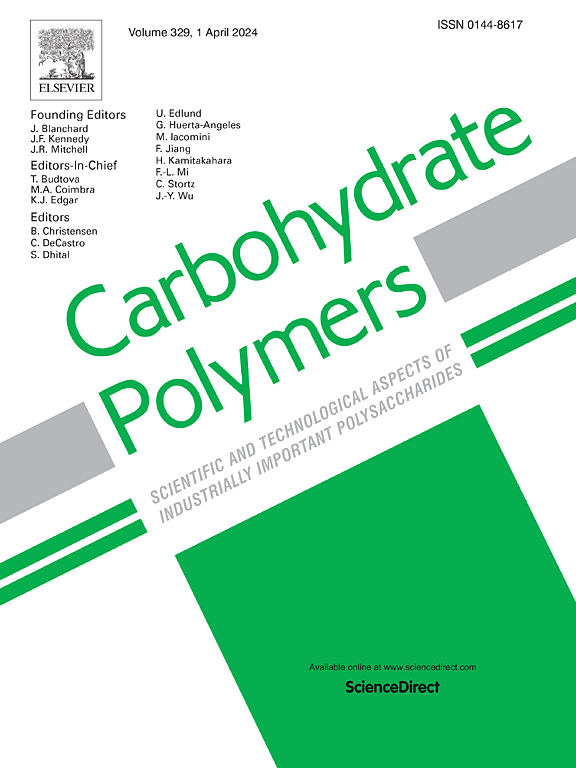通过控制松仁蛋白/蛋清蛋白热共聚集调控玉米淀粉的糊化和降解特性
IF 10.7
1区 化学
Q1 CHEMISTRY, APPLIED
引用次数: 0
摘要
由于植物蛋白和动物蛋白之间的构象关系存在矛盾,因此混合植物蛋白和动物蛋白来定制淀粉的性能具有挑战性。以蛋清蛋白(EWP)和松仁蛋白(PKP)为原料,制备了以玉米淀粉为基的EWP/PKP共混物和共沉淀物的三元基质,考察了它们对淀粉溶胶-凝胶转化和降解性能的影响。共沉淀处理通过增强疏水相互作用、二硫键和氢键重排,提高了双蛋白的内聚性和技术功能。当PKP:EWP为1:7时,共沉淀使凝胶化起始温度提高了7.30%,损失切线值提高了285.71%,凝胶硬度和断裂应力分别降低了114.32 g和9.17 kPa。在静电斥力和增强的氢键和疏水相互作用的驱动下,共沉淀物与淀粉形成均匀的凝胶基质。色度仪和LF-NMR结果表明,共沉淀物对凝胶亮度和水分分布有积极影响。对于退化,形成了大量的分子间二硫键,β-匝和随机线圈结构,驱动PKP, EWP及其共混物的自聚集。共沉淀形成了桥接的“封闭”网络,使R1047/1022和相对结晶度分别降低了48.21%和41.36%。这些发现为操纵双蛋白共聚集以实现淀粉水凝胶的按需功能化提供了科学指导。本文章由计算机程序翻译,如有差异,请以英文原文为准。

Modulating the gelatinization and retrogradation characteristics of corn starch by controlling pine kernel protein/egg white protein thermal co-aggregation
Blending plant and animal proteins to tailor starch performance is challenging due to contradictions in their conformational relationships. Herein, egg white protein (EWP) and pine kernel protein (PKP) were combined to prepare corn starch-based ternary matrices of EWP/PKP blends and co-precipitates, and their effects on starch sol-gel transformation and retrogradation properties were traced. Co-precipitation treatment improved the cohesion and techno-functionality of dual-proteins by enhancing hydrophobic interactions, disulfide bonds, and hydrogen bonding rearrangements. At a PKP:EWP ratio of 1:7, co-precipitates increased the gelatinization onset temperature by 7.30 % and the loss tangent values by 285.71 %, while the gel hardness and fracture stress reduced by 114.32 g and 9.17 kPa, respectively. Driven by electrostatic repulsion along with enhanced hydrogen bonding and hydrophobic interactions, co-precipitates formed a homogeneous gel matrix with starch. Results from chromameter and LF-NMR indicated that gel brightness and water distribution were positively influenced by the co-precipitates. For retrogradation, numerous intermolecular disulfide bonds, β-turns, and random coil structures formed, driving the self-aggregation of PKP, EWP, and their blends. Co-precipitates caused a bridged ‘closed’ network that reduced R1047/1022 and relative crystallinity by 48.21 % and 41.36 %, respectively. These findings offer scientific guidance for manipulating dual-protein co-aggregation for on-demand functionalization of starch hydrogels.
求助全文
通过发布文献求助,成功后即可免费获取论文全文。
去求助
来源期刊

Carbohydrate Polymers
化学-高分子科学
CiteScore
22.40
自引率
8.00%
发文量
1286
审稿时长
47 days
期刊介绍:
Carbohydrate Polymers stands as a prominent journal in the glycoscience field, dedicated to exploring and harnessing the potential of polysaccharides with applications spanning bioenergy, bioplastics, biomaterials, biorefining, chemistry, drug delivery, food, health, nanotechnology, packaging, paper, pharmaceuticals, medicine, oil recovery, textiles, tissue engineering, wood, and various aspects of glycoscience.
The journal emphasizes the central role of well-characterized carbohydrate polymers, highlighting their significance as the primary focus rather than a peripheral topic. Each paper must prominently feature at least one named carbohydrate polymer, evident in both citation and title, with a commitment to innovative research that advances scientific knowledge.
 求助内容:
求助内容: 应助结果提醒方式:
应助结果提醒方式:


